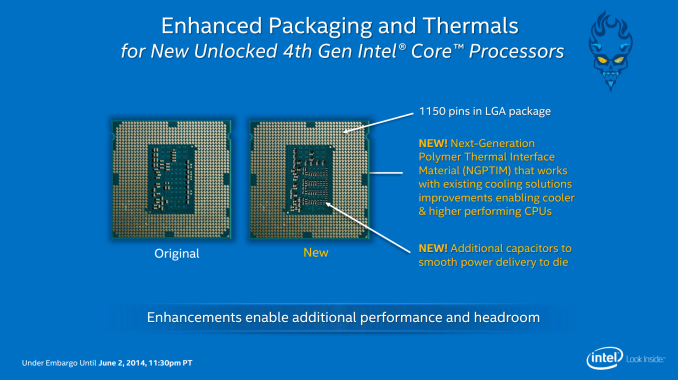Devil’s Canyon Review: Intel Core i7-4790K and i5-4690K
by Ian Cutress on July 11, 2014 10:00 AM EST- Posted in
- CPUs
- Intel
- Haswell
- i7
- Overclocking
- Devil's Canyon
- i5
- 4790K
- 4690K
Conclusions
End-users with CPU intensive workloads always feel justified in requesting for more performance. The only question is if that performance is required at the expense of power, and if the CPU company feel satisfied they can offer a higher performance component with absolute stability. Over the past three generations, Intel CPUs at equal frequency have offered a 5-10% performance boost over the previous generation, usually around the same power envelope. Because 2014 would seem to be a year where there is no major generation change for the mainstream market segment, in order to provide that 10% boost, they have had to go directly at clock speeds.
With the clock speed change, the package is also adjusted in two distinct ways. The first is to add extra decoupling capacitors on the PCB, allowing the voltage regulator on the die to deliver cleaner power to where it needs to go. The second addresses the issue of temperature, whereby the heat generated by the processor is removed. By adjusting the thermal interface material, Intel hopes to have a CPU that is ~10C cooler than the original Haswell CPUs at the same frequency and voltage. This latter part is directly observable, and even when overclocked, the ~10C temperature difference is very much visible.
This leads on to overclocking, the supposed reason for the release of Devil’s Canyon. Lisa Graff, VP and GM of Intel’s Desktop Client Platform Group, indicated in a press call before Computex that the lead design teams on Devil’s Canyon had six months to make the changes, and that the CPUs were aimed at addressing concerns levied at Intel from users who enjoy overclocking. The main concerns were the variability of the headroom of the Haswell CPU line, where some CPUs could only manage +5% whereas others gave +20% extra frequency, along with high temperatures at low clock speeds. By releasing the i7-4790K at 4.0 GHz/4.4 GHz Turbo, this ensures that the out-of-the-box i7-4790K has a better performance than the lowest performing overclocked i7-4770K CPUs. The adjustment in the thermal interface material (which we suspect is a change in the ceramic filler to an aluminum oxide or derivative therein) also gives more headroom for the i7-4790K CPUs that might have been temperature limited otherwise.
For our overclocking performance, both of our CPUs were hitting their voltage limitations as a result of the temperature adjustment. At the top end of our final overclocks, in order to adjust +100 MHz to be fully stable required a large jump of +0.100 volts, pushing the CPU voltage outside of the recommended window for a 24/7 stable Haswell-based processor. Both the i7-4790K and the i5-4690K in our testing gave 4.7 GHz benchmark stable, 100 MHz more than our first i7-4770K sample and 500 MHz more than our second i7-4770K sample.
This ends up being the main selling point for the overclocking end-user: if you own a relatively mediocre Sandy Bridge, Ivy Bridge or Haswell CPU, and have CPU limited throughput, there can be performance gains by investing into the Devil’s Canyon (CPU + Z97 motherboard or Z87 with BIOS updates) ecosystem. These are ‘enhancements’ that Intel should build on for the future, and never remove. I am sure that many enthusiasts would like to see a return to soldering the IHS on, or a single version with this feature.
For users relying on an Ivy Bridge stock system, the i7 Devil’s Canyon can offer a 17% increase over the i7-3770K for CPU benchmarks. For those that need the fastest single-thread VT-d enabled processor according to Intel's specification pages, the i7-4790K also affords that opportunity.
Users that are looking for the fastest GPU for gaming, at 1080p, might not be impressed by either the i5 or i7 Devil’s Canyon. At least in our testing, we saw no improvement from Ivy Bridge to Devil’s Canyon. One might argue that the story would be different for online gaming, or at larger resolutions, however for the latter there is more emphasis on upgrading the GPU over the CPU. While some hardware setups offer this mainstream CPU with three and four-way GPU gaming, typically we end up recommending the extreme platform due to fewer PCIe switches required.
The next question is oriented towards the future. Will the next generation of Intel CPUs perform better than Devil’s Canyon? The expected release date of Broadwell CPUs is still unknown, as is the extent of Intel's desktop offerings. Some media are expecting Broadwell to be more IGP focused as a platform, given the initial expectations of no desktop parts. To put this into perspective: if Broadwell offers a 5-10% IPC increase, Intel has to offer a 4.0 GHz / 4.4 GHz Turbo version in order to make their fastest mainstream processor even faster. However, given the history of Intel’s releases, if they release a top end i7, it will most likely be a 3.6 GHz / 4.0 GHz Turbo part, and offer the same performance as Devil’s Canyon. We cannot predict the overclocking potential, or if Intel is going to migrate the ‘enhanced overclocking features’ of Devil’s Canyon to the new parts. If this is the case, Intel will have to offer a new 'feature' to help sell the new high end parts.
The user has to hedge their bets – when is Broadwell coming to market, and is there going to be a large OC version of Broadwell, the equivalent of Devil’s Canyon is to Haswell? We are currently looking at 5 months away from Broadwell-Y (also known as Core-M) based on Intel announcements but no indication yet when Broadwell-DT is released, meaning an investment in Devil’s Canyon gives the top class mainstream processor based system until then.
The next piece of the puzzle is Haswell-E where many sources, such as CPU-World, are quoting that the low end SKU (an i7-5820K going by previous naming schemes) will be a six-core 3.3 GHz CPU with some amount of turbo. Historically Intel has charged roughly the same amount for the lowest Enthusiast CPU and the top Mainstream CPU, although this time the lowest Enthusiast CPU will have two more cores. So until Haswell-E is released, along with DDR4 and the X99 chipset, Devil’s Canyon might sit in the ‘should I wait’ category. But if we were looking at upgrading that main system today, based on CPU limited workloads, the i7-4790K is a well recommended choice.














117 Comments
View All Comments
Braincruser - Sunday, July 13, 2014 - link
Rendering should be left to GPU cores in shaders. They scale much much better than cpu.Mark-Benney - Thursday, August 14, 2014 - link
I wrote out a the Manderoot program on a Acorn Electron 32k, Back in the very early days. Took 48hrs to complete up on books with fan placed under it. Lol bet you were not even born when i first wrote program in Dos/Machine code/Pascal/BBC Basic. And still in nappys when I was overclocking a Intel Celron from 233mhz to a stable 24/7 367mhzCrystalBay - Monday, July 14, 2014 - link
Thanks Dr. Ian I love my Intel 4790K @ 4.8 Ghz , I also love Asus Z97 Deluxe . This isa the simplest way to OC in my 25 years of building PC's ... Screw it being AVX stable capitol BS never will be used instruction . Any modern chip fails at it anyway ... Go Devils ,go AMDpcjoeyd - Wednesday, February 18, 2015 - link
crystalBay,,, not ANY modern chip fails...just your unstable cpu setup. why run at 4.8ghz and run your cpu super hot? bump it down to 4.6-4.7ghz (you won't notice any difference), run your cpu much cooler and be 100% stable.superjim - Tuesday, July 15, 2014 - link
Intel hasn't made a good OCing chip since Sandy Bridge. Devil's Canyon just reinforces how good SB was. Nearly every i5 and i7 chip could hit 4.4 without issue with most at 4.6+ on a good air cooler. Raise your hand if you're still on SB only because there is nothing better...AlucardX - Tuesday, July 15, 2014 - link
same here. I'm on 2500k at 4.5 GHz. I kept reading this article to try to determine if it was time for a rebuild, and i guess the answer is no. this would be more appealing if the i7 had true 8 core CPU's in itjloutz - Thursday, July 24, 2014 - link
Completely agree with above posts. I'm at 4.5 GHz on closed loop water on a 2500k and this thing has been rock solid for four years (by far the longest upgrade cycle since I started DIY builds in 1998. I believe I got a Microcenter CPU/ASUS MB bundle for ~ $300 (wow!) I've added SSD's and a new graphic card, but still itching for a CPU/MB chipset upgrade. Let's see what Skylake brings to the party??pcjoeyd - Thursday, February 19, 2015 - link
yep, no need to get anything greater than sandybridge as it stands now. I have my 2600k i7 clocked at 4.4ghz super stable and cool. My daughter's pc I have her 2500k running at 4.7ghz. I'm using Noctua NH-U14S coolers in both systems. Rock solid, runs cool and super QUIET!!MrSpadge - Saturday, July 26, 2014 - link
Switched from Sandy to Ivy for the better power consumption under moderate OC (4.1 GHz @ 1.03 V). Running 24/7 load on it, so even stock voltage (1.18 V) is far too expensive.bhima - Sunday, August 3, 2014 - link
Still rocking my i5-2500K at 4.2 on air. I could go higher, but I'm pretty conservative when it comes to OC. I have no need to upgrade as games aren't bottlenecked by my processor, and using the Adobe suite is still a trivial task for Sandy Bridge.